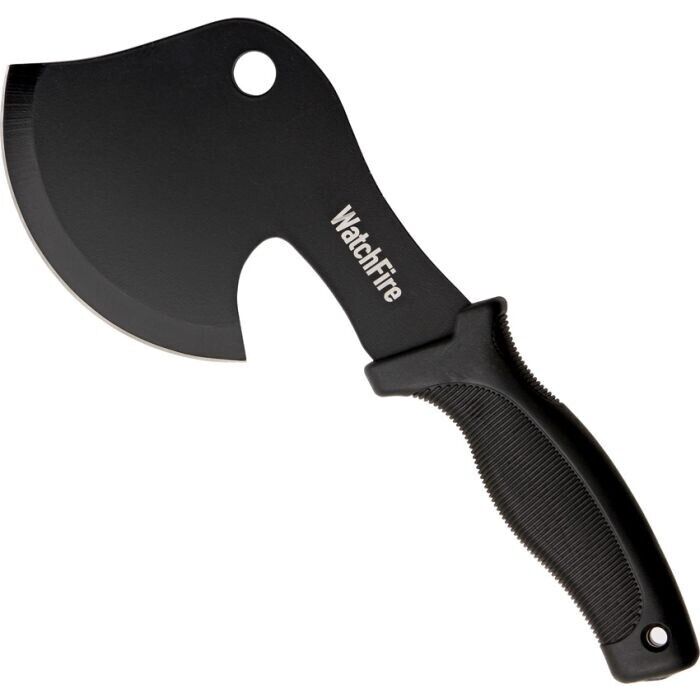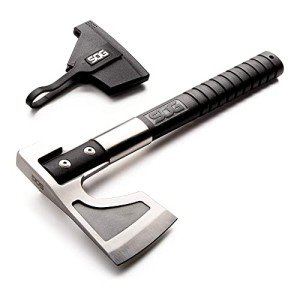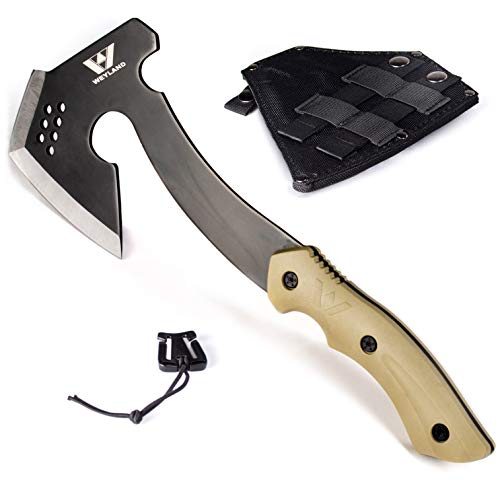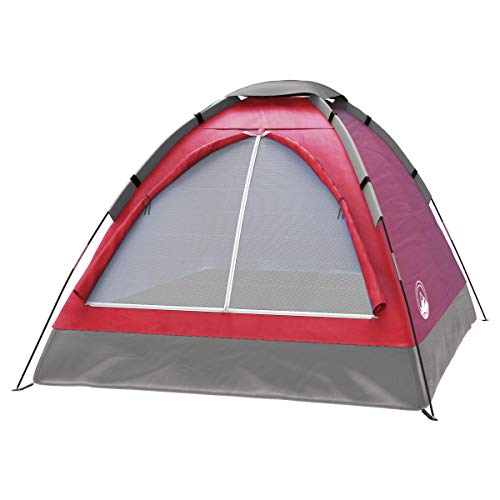Here's a friendly, in‑depth review of the Gerber Gear Downrange Tactical Tomahawk – a heavy-duty, multi-purpose survival and breaching tool.
🔍 Overview & First Impressions
At approximately 19 inches long and weighing around 1.9 pounds (2.5 pounds with sheath), the Downrange Tomahawk is a full-tang, rugged tool crafted from a single piece of 420HC stainless steel with a Cerakote finish. The desert-tan G-10 handle scales provide excellent grip and are integrated with finger grooves to aid control. The sheath is MOLLE‑compatible, letting you attach it to gear or body armour for quick access.axeing.org+2platatac.com
Even before the first swing, the tool exudes a military-grade vibe—sturdy, serious, no-nonsense.
✔️ Key Strengths
-
Versatile Triple Threat Head
-
Durable Construction
The 420HC steel and Cerakote finish resist corrosion, while the full tang and G-10 scales withstand abuse. Field testing includes smashing concrete, rocks, nails, pallets, and even tree limbs—no bending or cracking is observed. -
Balance & Control
Despite its size, balance is good—gripping near the head allows fine chopping, while the handle works well for power moves. Even heavier tasks like splitting saplings are doable.amazon.co -
High-End Craftsmanship
Entirely made in the USA (Portland, OR), reflects Gerber's decades of expertise. Backed by a limited lifetime warranty. tikt. -
Practical Sheath Design
The MOLLE-ready sheath with dual snaps keeps your tool secure and deployable quickly—the head cover snaps on even during prying for fast access.
⚠️ Considerations & Drawbacks
-
Minimal Cutting Edge
The blade is intentionally rounded and not sharp enough to split wood or slice rope without sharpening. Many owners manually sharpen it. -
Steel Quality
420HC is a mid-grade stainless, not top-tier on edge retention. Still, well-heat-treated and corrosion-protected, it holds a decent edge. -
Sheath Flimsiness
Some users report that the sheath can be a bit weak; in vehicles, snaps may roll loose unless they are secured correctly. -
Weight & Size
Heavier and larger than a hatchet. More suited to breaching than backpacking—less ideal for long-distance hikers. -
Pricey
MSRP around $249–285; some users consider that steep, though discounts sometimes bring it near $200.
🧪 Real-World Use Cases
Field tests and anecdotal experiences highlight the tool's capabilities:
-
Breaking apart oak pallets: Chop and pry through with ease. No visible damage after multiple cycles. recon-c
-
Concrete smashing: Hammer end chipped concrete blocks without bending the head .amaz
-
Extreme environments: Withstood freezer and fire exposure, still intact with no misalignment or warping .
-
Camp chores: Splitting smaller limbs for firewood was feasible, although a conventional hatchet is faster.
-
Vehicle mounting: Some mounted it with aftermarket clamps (e.g., Quick Fist) for fast access—snap sheath alone may not hold in rough terrain.
🎥 Watch It In Action
Here's an excellent video featuring actual use, including chopping, prying, and breaching:
It shows everything from hardware removal to wood chopping and concrete striking—it's a fantastic visual companion to this review.
🤔 FAQ – Frequently Asked Questions
Q1: Is it worth the price?
A: If you're equipping a vehicle, tactical team, or disaster-response kit, yes—the tool's versatility and durability justify the cost. For camp use or casual purposes, a basic axe or hatchet might offer better value.
Q2: How sharp is it out of the box?
A: The edge is intentionally dull for safety and durability. Many users note it performs better after sharpening.
Q3: What steel does it use, and how's the edge retention?
A: Made of 420HC stainless steel with Cerakote. While not premium steel, it's well-heat-treated. Good edge retention considering its breaching design—but expect some maintenance.
Q4: Can I split firewood with it?
A: Yes, for small limbs and kindling. Large logs? You're better off with a dedicated axe or saw.
Q5: How durable is it under extreme conditions?
A: Rugged. Withstood hammering nails, smashing concrete, fire exposure, cold, even freezer conditions—remained straight and solid.
Q6: Is the sheath reliable?
A: It's serviceable, MOLLE-ready, and deployable during use—but securing it (especially the bottom snap) is crucial if in a moving vehicle or rough terrain.
Q7: Can I carry it on my back?
A: You can, but it's large and heavy. Better suited to vehicle or gear loadouts than through-hike packs.
Q8: Is a full tang better?
A: Yes—this tomahawk is a full tang, delivering reliability and strength. A few clones on the market may skimp here, so ensure authenticity.
⚖️ Pros & Cons at a Glance
| 👍 Pros | 👎 Cons |
|---|---|
| Triple-tool head: axe, hammer, pry bar | Edge dull by design—needs sharpening |
| Sturdy construction, full tang | 420HC is mid-tier steel |
| Balanced weight & precise grip | Heavy and long—less camping friendly |
| MOLLE sheath—fast deployment | Sheath snaps may loosen in vehicles |
| USA-made, lifetime warranty | Pricey for casual users |
🧭 Who's It For?
-
Tactical units / First responders / Breachers – A must-have for forced entry, rescue, or barrier removal.
-
Survivalists / Bug-out vehicles – A multi-function tool for prying, smashing, chopping, eand ven basic digging.
-
Outdoor gear collectors – Rugged and made in the USA.
-
Not ideal for: Thru-hikers, backpackers, or those seeking everyday camp axes.
🔚 Final Verdict
The Gerber Downrange Tomahawk is a robust, versatile, mission-driven tool—designed for breaching, prying, chopping, and hammering. It delivers on its promises: built tough, well-balanced, and able to withstand abuse in realistic field scenarios. Yes, it's heavy and the blade needs sharpening, but that's part of the design: better dull than brittle, ready for your next operation.
If you need a hard‑working multi‑tool for serious missions or serious survival setups (especially in vehicles), it's worth its price tag. If you need a camp axe, a simpler option may serve better.






